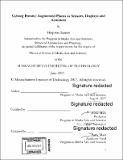Cyborg botany : augmented plants as sensors, displays and actuators
Author(s)
Sareen, Harpreet
DownloadFull printable version (16.42Mb)
Alternative title
Augmented plants as sensors, displays and actuators
Other Contributors
Program in Media Arts and Sciences (Massachusetts Institute of Technology)
Advisor
Pattie Maes.
Terms of use
Metadata
Show full item recordAbstract
Plants are photosynthetic eukaryotes with a billion years of evolutionary history. While primarily sessile, they have developed distinctive abilities to adapt to the environment. They are self-powered, self-fabricating, self-regenerating and active signal networks. They carry highly advanced systems to sense and respond to the environment. We strive for such sensing and responses in our electronics; self growing or self repairing abilities in our architecture; and being sustainable at scale in general. The industrial and technological thought process has mostly been devising artificial means or replicating natural systems synthetically. However, I propose a convergent view of technological evolution with our ecology where techno-plant hybrids are created. The approach is to formulate symbiotic associations and to place the technology in conjunction with the plant function(s). In this thesis, I go from the outside to inside the plants in conceiving such synergetic processes and present case studies of their implementation and analysis. I begin with a robot-plant hybrid where the robotic device adds mobility and is triggered with the plant's own signals. Next, lead (II) detection nanosensors are presented which reside inside the leaf of a plant and continuously sample through plant hydraulics. This is followed with a design study for plants with new conductive channels grown inside them and their subsequent use as inconspicuous motion sensors. I conclude with a symbiotic robot that lives on a sunflower plant and automatically trains or directs its growth with onboard lighting. The end result is an augmented-plant society where technology adds non-native functions or redirects the natural processes..
Description
Thesis: S.M., Massachusetts Institute of Technology, School of Architecture and Planning, Program in Media Arts and Sciences, 2017. Cataloged from PDF version of thesis. Includes bibliographical references (pages 94-98).
Date issued
2017Department
Program in Media Arts and Sciences (Massachusetts Institute of Technology)Publisher
Massachusetts Institute of Technology
Keywords
Program in Media Arts and Sciences ()